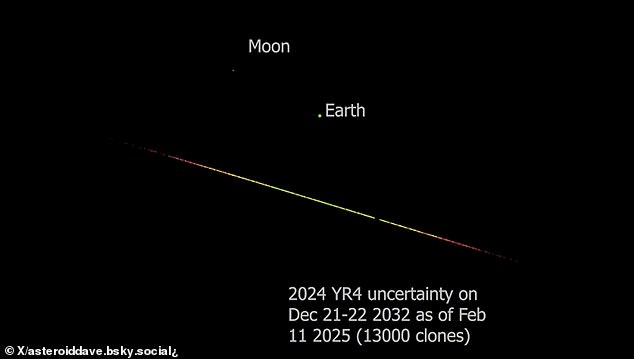
Simulation Tracks Earth-Bound ‘City-Destroying’ Asteroid Path as Moon Faces Collision Risk: Scientists
Terrifying Animation Reveals Path of "City-Killer" Asteroid Headed Toward Earth
[Image 1: Simulation showing asteroid’s path near Earth and Moon]
*A chilling new animation reveals the trajectory of asteroid 2024 YR4, a potential "city-destroyer" with a 2.1% chance of striking Earth on December 22, 2032. Calculations by Dr. David Rankin (University of Arizona’s Catalina Sky Survey) also suggest a 0.3% chance of a Moon impact.
Impact Risks and Destructive Power
The 40–90-meter asteroid, first detected in December 2024 by NASA’s ATLAS system, could unleash energy equivalent to 15 megatons of TNT—100 times more powerful than the Hiroshima atomic bomb. For context, the Tunguska asteroid (1908) flattened 830 square miles of forest and was similar in size.
[Image 2: Tunguska event aftermath compared to 2024 YR4’s potential impact]
Moon Impact: A Spectacular Threat?
A lunar collision would occur at 31,000 mph, creating a 2km-wide crater and an explosion 343 times Hiroshima’s force. While debris might shower Earth, experts deem it harmless. "The impact flash would be visible from Earth, even in daytime," said Imperial College’s Prof. Gareth Collins.
[Image 3: Graphic of asteroid hitting the Moon’s surface]
Shifting Probabilities and Observations
Initial Earth impact odds rose from 1.2% to 2.3% before settling at 2.1%. NASA and ESA have urgently enlisted the James Webb Space Telescope (JWST) for precise size measurements. March and May 2025 observations are critical before the asteroid dims until its 2028 return.
[Image 4: James Webb Telescope capturing asteroid data]
Deflection Dilemma
NASA’s 2022 DART mission successfully altered an asteroid’s path by crashing a spacecraft into it. However, deflecting 2024 YR4 within eight years poses challenges. “You need 10+ years to plan such a mission,” warned volcanologist Dr. Robin George Andrews.
[Image 5: DART spacecraft colliding with asteroid Dimorphos]
What’s Next?
While most likely to bypass Earth, 2024 YR4 remains a rare high-risk asteroid. Ongoing tracking aims to refine its trajectory, potentially ruling out collision scenarios. Until then, planetary defense teams prepare for all outcomes, hoping to avert a historic disaster.
Key Facts About 2024 YR4
- First Detected: December 2024
- Speed: 29,000 mph (relative to Earth)
- Closest Pass: December 2032
- Current Earth Impact Probability: 2.1% (1 in 48)
[Image 6: Infographic summarizing asteroid details and risks]
Final updates await JWST’s findings, which could determine whether emergency deflection talks escalate.


